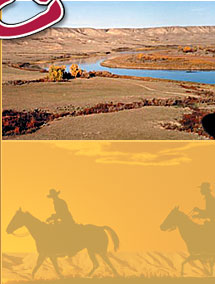

|
|
|
| Our Lodge |
|
|
|
|
| Tour Information |
|
|
|
|
| Area History |
|
|
|
|
| Photo Gallery |
|
|
|
|
| Reservations |
|
|
|
|
| Links |
|
|
|
|
| Contact Us |
|
|
|
|
|
|
|
|
|
|

 |
| South Saskatchewan River Behold the South Saskatchewan and marvel. For here is the southern Alberta's river of all rivers. It is north of Grassy Lake, Alberta, at a scenic place called The Grand Forks, where the union takes place which results in the water course officially named the South Saskatchewan. Here is what happens at The Grand Forks: The Oldman comes in from the west and meets the Bow which has meandered in from the north, and presto, we have the South Saskatchewan. From here, the river makes its way downstream, glides along the base of Redcliff’s red cliffs, and wanders through the city of Medicine Hat. Just outside there, it contorts crazily before more or less straightening out. Then it crosses the Canadian Forces Base Suffield, and joins the Red Deer River just across the Saskatchewan border. After this union, it is forward ho to Hudson Bay. Paragraph taken from the book “Rivers We Love – Southern Alberta’s Lifelines.” Written by Jim Asplund. |
| In Alberta, the South Saskatchewan runs for most of its
length in a deeply incised valley through some of the most
extensive native grasslands remaining in Canada. For much of
this 320 KM course, the river offers landscapes that are
still essentially wild and often dramatically beautiful. It
also offers marvelous opportunities for seeing and hearing
wildlife along its reaches where point bars and islands,
broad terraces of grass and sagebrush, gallery forests of
cottonwoods, badlands and coulees provide year-round or
seasonal habitats for many different species. Unlike the white water rivers of mountains and foothills, the South Saskatchewan does not insist on life in the fast lane. The thrills and skills involved in paddling the river are of a different order. There is time to watch and listen; time to wonder and reflect; time to gain a sense of history and a sense of place. The waters of the South Saskatchewan come principally from the glaciers and snow packs of the Rocky Mountains through the Bow and Oldman rivers, which meet at Grand Forks. Over the last 10,000 years, these waters have eroded a channel through the gravel, sands and silts left during the Pleistocene glaciations, down through the older sandstones and shales of the upper Cretaceous Period, to form a valley from 60 to 150 meters below the level of the surrounding plains. From Medicine Hat to Drowning Ford, the river follows the valley of a pre-glacial river. Here it meanders through a wide flood plain; elsewhere, it has cut a less sinuous channel. In some reaches, flood plain and river terraces are all but crowded out as the valley narrows to form a canyon. While traders, government expeditions, North West Mounted Police and Dominion surveyors left in passing some written records of the river as it was prior to European settlement, the native inhabitants, with their tradition of oral history, wrote their records of passage in rocks. Tipi rings and rock cairns are numerous in prairie grasslands above the river valley. Information taken from the book “Prairie River” – written by Dawn Dickinson and Dennis Baresco |

| Copyright 2017 - River Bend Jet Boat Tours All Rights Reserved. |





